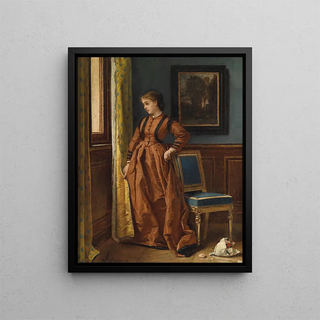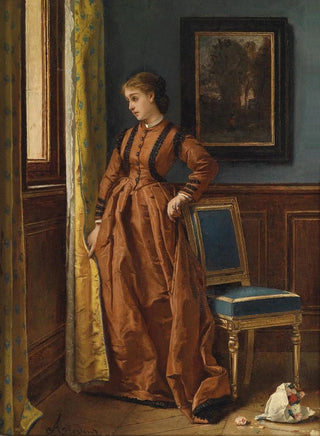Art print | Déjà - Alfred Stevens


View from behind

Frame (optional)
Déjà - Alfred Stevens – Captivating Introduction
In the fascinating world of art, some works manage to capture the essence of their era while resonating deeply with contemporary viewers. "Déjà" by Alfred Stevens is a perfect example. Painted at the end of the 19th century, this painting not only evokes the bourgeois lifestyle of its time but also a sensitivity that transcends generations. The scene depicted by Stevens invites the viewer to immerse themselves in a world of refinement and beauty, where every detail seems to tell a story. The art print of "Déjà" thus allows for appreciating this masterpiece from a new perspective, offering privileged access to its delicate aesthetics and the emotions it conveys.
Style and uniqueness of the work
What immediately strikes in "Déjà" is the exquisite mastery of color and light that characterizes Stevens's work. The warm tones and delicate nuances blend harmoniously, creating an intimate and welcoming atmosphere. The composition, carefully orchestrated, highlights characters with contemplative gazes, immersed in silent reflection. This depiction of everyday life, imbued with melancholy and softness, bears witness to a unique sensitivity. The meticulous details, from the drapes of clothing to carefully chosen accessories, reveal a concern for realism that immerses the viewer in a bygone era, while also prompting reflection on the human condition. Stevens succeeds in combining the charm of the past with timeless modernity, making "Déjà" a work of rare singularity.
The artist and his influence
Alfred Stevens, an emblematic figure of the realist movement, distinguished himself by his ability to capture the essence of bourgeois life and its subtleties. Born in Brussels in 1823, he spent much of his career in Paris, where he mingled with many influential artists of his time. His style, both refined and accessible, left a mark on his contemporaries and continues to inspire subsequent generations. Stevens also took an interest in the representation of women in society, addressing themes of beauty, grace, and the complexity of emotions. His artistic legacy is undeniable, and his work

Matte finish

View from behind

Frame (optional)
Déjà - Alfred Stevens – Captivating Introduction
In the fascinating world of art, some works manage to capture the essence of their era while resonating deeply with contemporary viewers. "Déjà" by Alfred Stevens is a perfect example. Painted at the end of the 19th century, this painting not only evokes the bourgeois lifestyle of its time but also a sensitivity that transcends generations. The scene depicted by Stevens invites the viewer to immerse themselves in a world of refinement and beauty, where every detail seems to tell a story. The art print of "Déjà" thus allows for appreciating this masterpiece from a new perspective, offering privileged access to its delicate aesthetics and the emotions it conveys.
Style and uniqueness of the work
What immediately strikes in "Déjà" is the exquisite mastery of color and light that characterizes Stevens's work. The warm tones and delicate nuances blend harmoniously, creating an intimate and welcoming atmosphere. The composition, carefully orchestrated, highlights characters with contemplative gazes, immersed in silent reflection. This depiction of everyday life, imbued with melancholy and softness, bears witness to a unique sensitivity. The meticulous details, from the drapes of clothing to carefully chosen accessories, reveal a concern for realism that immerses the viewer in a bygone era, while also prompting reflection on the human condition. Stevens succeeds in combining the charm of the past with timeless modernity, making "Déjà" a work of rare singularity.
The artist and his influence
Alfred Stevens, an emblematic figure of the realist movement, distinguished himself by his ability to capture the essence of bourgeois life and its subtleties. Born in Brussels in 1823, he spent much of his career in Paris, where he mingled with many influential artists of his time. His style, both refined and accessible, left a mark on his contemporaries and continues to inspire subsequent generations. Stevens also took an interest in the representation of women in society, addressing themes of beauty, grace, and the complexity of emotions. His artistic legacy is undeniable, and his work






